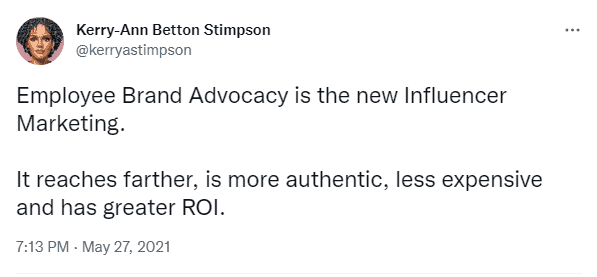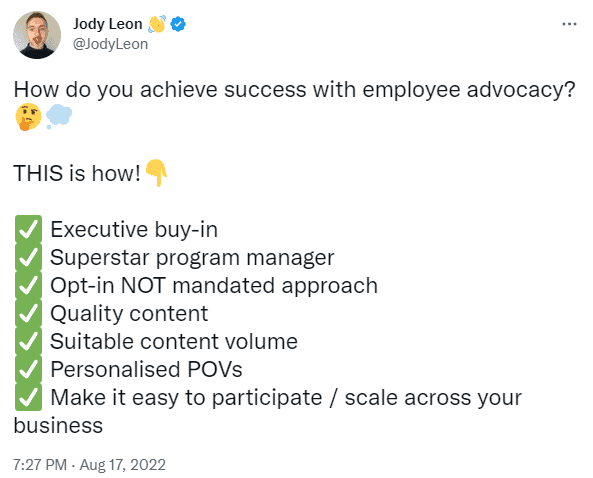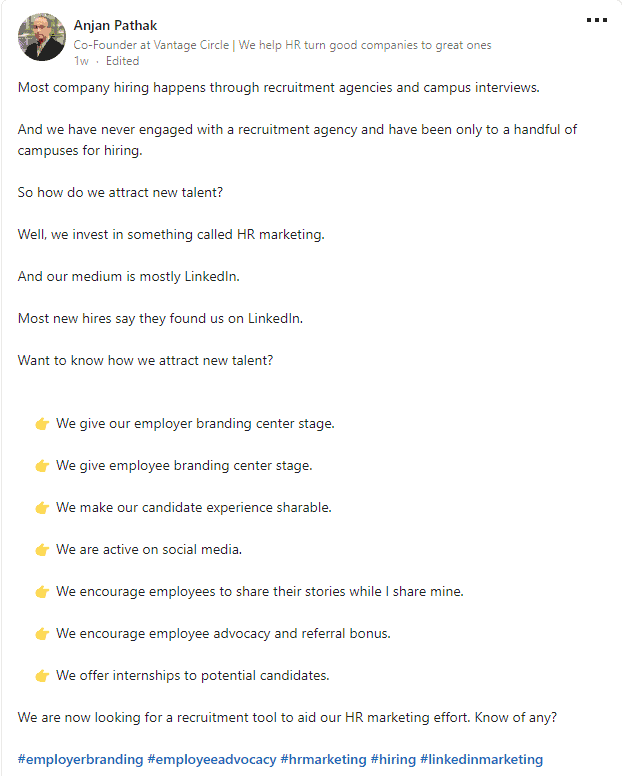Employee advocacy is great for improving a company’s public image. The main idea behind it is to harness the power of current employees by encouraging them to share information about their workplace, which ultimately helps improve their brand’s public image.
Employee advocacy is excellent for creating a community around the brand and hiring more great people. After all, people that already like working at the company are more suitable to speak about the work environment, how they fit in with the culture, and are more productive. Still, it is easier said than done.
Employee advocacy is a long-term strategy that requires a proper implementation plan. In this article, we will look at what employee advocacy is, why it’s necessary for employers and employees, and a step-by-step guide on how you can leverage it to hire better-quality candidates.
What is employee advocacy?
Employee advocacy is a communications strategy that allows employees to openly voice their opinions about their work environment, the company, and its employees. Employee advocates are people who are willing to give feedback regularly so they can help improve the workplace culture.
Employee advocates are valuable because they have first-hand experiences with problems at their workplace. This allows them to offer suggestions on how to fix these issues, effectively improving the team’s performance and the overall morale of everyone involved.
Importance of employee advocacy
Employee advocacy is important for employers and employees alike. Employers can find it difficult to keep up with the pace of modern-day business, and employees need to maintain some sense of security in their respective industries.

Source: Kerry-Ann Betton Stimpson
According to AdWeek, 76% of the people surveyed stated that they are more prone to trusting content shared by real people over the content put out from brand accounts.
For company:
1. Increases sales
Employee advocacy allows people to hear about your business from a trustworthy source. This can be more effective than sales tactics since people trust their peers. Employee advocacy creates a positive image for your business, which can help attract more potential customers.
2. Brings in better talent
With the right strategy, employee advocacy can help you reach the talent you need to fill your open roles. This is because social media can be an excellent tool to match job seekers to open roles and increase your chances of finding a candidate who fits your needs because of your employees rallying for your company.
Neal Taparia, who runs the gaming platform hearts.land explains, “All our employees have come from referrals. If your team enjoys working for you, they’ll be motivated to refer people from their network, bringing your recruiting costs down significantly.”
3. Improves employee engagement and productivity
When employees are engaged, they feel a higher sense of engagement and ownership for their work and a desire to perform well. Engagement improvements also improve employees’ productivity, allowing them to focus on the task at hand and with a greater sense of motivation. With these factors working in the company’s favor, they can start enjoying higher revenue.
4. Builds audience trust
Employees who advocate for their company on social media create more buzz around the brand. More people start to trust the brand, which is what businesses want. In the long run, it’s a huge asset for any company looking to attract new customers. The more trusted the brand is, the more people will be interested in its products and the more customers they will gain.
5. Helps marketing budget
When an employee advocates for their company on social media, the company spends less on marketing because the organic content spreads directly to their potentially intended audience without paying for ads. As these influencers share their enthusiasm for the company and its product or service, they’re bringing their network with them, who are likely to become long-term customers.
For employees:
1. Content for social media
Employees can produce unique, in-depth content spread across their social media accounts, or at least platforms like LinkedIn for professional updates. This will help keep the content relevant, engaging, and up-to-date and ensure that the business is represented in the best light possible, all while helping the employee remain active on their social accounts.
2. Networking opportunities
The days of business people being behind closed doors and inaccessible are over. Today’s landscape expects businesses to be human and accessible. That’s why businesses encourage their employees to be active on social media.
Every employee can create social content about their role in the company, giving consumers a window into the company culture and atmosphere. Employees who create social media content around their roles and company open themselves to networking opportunities. When they engage on social media, they make acquaintances with various influential people in their industry.
3. Picking new skills
When creating content, employees can learn new skills like personal branding and business writing. Employees can create social media content around their roles and company. They can create a personal brand by writing about what they do, positively reflecting on their work and the company, and seeking advice for challenging aspects of their jobs.
7 Steps To Leverage Employee Advocacy In Social Hiring
Here is an effective guide on how to make the most of employee advocacy while hiring for open roles-

Source: Jody Leon
Get leadership approval
You should have leadership support to develop a program to get employees talking and sharing your brand. This step is the foundation since they are a great starting point to spread the word on their social accounts first and because they bring a level of trustworthiness to the initiative.
To increase your chance of getting buy-in from leadership, it’s best to create a presentation highlighting its benefits, build case studies to show the results of well-executed programs, and other data points that make it look like an easy decision.
List goals and KPIs for the program
Some of your employees may be already sharing glorious reviews and happenings in the company, while others are interested but do not know how to get started. When you set goals for your employee advocacy program and communicate them to the team, you increase your chances of making it a success.
Also, it helps you track your initiatives’ success when you have clear goals and metrics. While there is a higher chance of getting leads and sales from these programs, HR leaders can benefit by attracting top-notch candidates for open roles that suit the company culture.
Some key metrics you may track are:
- Promoters or employees who advocate for the company often
- Reach and traffic
- Brand sentiment
You can further simplify this process by creating a branded hashtag such as #(companyname)cares or #employeesof(companyname). You can create a dedicated social media page to attract traffic to a single source or share staff-related updates like Starbucks.

Source: Starbucks Partners
Create a dedicated committee
Creating an employee advocacy committee is a great way to involve employees in decision-making. Ideally, these will be members outside of leadership roles who can actively participate in the committee to oversee the program and fine-tune the processes.
Members should be involved in day-to-day operations and should be empowered to make decisions on their own. This will increase morale, and your employees will feel they can make a difference in the company. This will help them feel ownership of the initiative, which may lead to the program’s success.
Create a strong company culture
Company culture is all about how people are treated in the workplace. A positive work environment leads to higher morale, work ethic, and productivity. Having a strong company culture can also help you grow your business.
When teams are highly productive, they can aid in boosting the company’s profit margins. If you can get your employees loyal to your company, they’ll be more willing to go the extra mile to help when the company needs their services.
Consequently, you organically create advocates by having an uplifting and collaborative work culture.
Provide meaningful benefits
It’s not enough to hire someone; ensure you give benefits that promote growth. Treating your employees as people who drive your business to success will reflect positively on your company.
A business can only be as good as its employees, and if you take the right steps in hiring, training, and investing in your team, you will get a company filled with prominent advocates who will sing your praises to their peers and network.
How can you do this? Start by offering meaningful perks to them so they can do their job better. You can provide life insurance, offer parental leaves, courses to help them upskill, and more.

Source: Anjan Pathak
Equip them with the right resources and tools
Most people who work in an office environment want to make a valuable contribution to the company they work for. That’s why employers must empower their employees with the guidance, motivation, and tools they need to do their jobs. For example, your marketing team can use Testbox to evaluate software they may need to do their job well.
A company building a recognizable voice of its brand on social media benefits from an empowered employee with the right tools. This will attract top talent to your company. The idea is to use social media to build relationships with potential employees by leveraging your existing networks. For this, you need to create a company image that is both professional and personable.
Help the employees with proper social media guidelines
While the employees might understand they need to portray the company positively on social media, they may struggle to know how to share the information correctly. They may be concerned about the tone of voice, frequency of posts, or even how to engage meaningfully with queries on their posts.
To come on top of the whole exercise, it is best to create social media guidelines that address:
- Must-have content (e.g., a takeaway)
- Nice-to-have content (e.g., call-to-action or brand hashtags)
- Content to avoid (e.g., politics and religion)
You can also assist them with your brand kit, such as the logo, USP, tone of voice, visuals, etc. Further, you can even create content templates to kick-start the campaign. Lastly, remember not to micromanage employee posts since it may look forced and lead to promoters becoming detractors.
Social Hiring: Quick Overview
If you have already been advocating for your brand on social media, it might be time to take a closer look at your social strategy. Understanding why you’re trying to convince your team to get on board is vital. If you just want everyone to share stuff about your business, you will have difficulty getting the results you want since it might look forced.
A better strategy is to involve people in the process by showing them you care about the company as much as they do and go the extra mile to ensure everyone is happy.
Before implementing an employee advocacy program in your organization, you must realize that the foundation lies in a robust company culture. A lot of work goes into running a successful business, most of which is done by the employees. Make sure you appreciate them, and you’ll see that it’s worth the extra effort.
If you want employees to feel like they’re part of something bigger than themselves, stick with your messaging and brand identity throughout the year. This will help build up morale among employees, who see that management appreciates their efforts.
Finally, avoid creating an employee advocacy program that feels overly promotional since their peers in the industry will view it as dubious or boastful.

